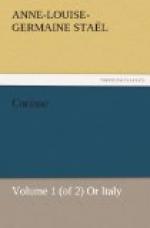Corinne and Lord Nelville finished the day with a visit to the studio of Canova, the greatest modern sculptor. As it was late when they got there, they were shewn it by torch light; and statues improve much in their effect by being seen in this manner. The ancients appear to have been of this opinion, since they often placed them in their Thermae, where day could not enter. By the light of the flambeaux, the shadows being more full, the uniform lustre of the marble was softened, and the statues appeared as so many pale figures, possessing a more touching character of grace and life. There was, in the studio of Canova, an admirable statue destined for a tomb, which represented the genius of grief leaning upon a lion, the emblem of strength. Corinne, in contemplating the figure of grief, thought she discovered in it some resemblance to Oswald, and the artist himself was struck with it; Lord Nelville turned about to avoid this kind of notice; but he said in a low voice to his fair companion, “Corinne, I was condemned to a fate like that which is here represented, when I met with you; but you have changed my existence, and sometimes hope, and always an anxiety mixed with charm, fills that heart which was to suffer nothing but regret.”
Chapter iii.
The masterpieces of painting were then all collected together at Rome, whose riches in this respect surpassed that of all the rest of the world. There could exist only one disputable point as to the effect produced by this collection, namely, whether the nature of the subjects chosen by the Italian artists, afford a scope for all the variety and all the originality of passion and character which painting can express? Oswald and Corinne were of contrary opinions in this respect; but this, like every other opposition of sentiment that existed between them, was owing to the difference of nation, climate, and religion. Corinne affirmed that the most favourable subjects for painting were religious ones[26]. She said that sculpture was a Pagan art, and painting a Christian one; and that in these arts were to be found, as in poetry, the distinguishing qualities of ancient and modern literature. The pictures of Michael Angelo, the painter of the Bible, and of Raphael, the painter of the Gospel, suppose as much profound thought, as much sensibility as are to be found in Shakespeare and Racine: sculpture can only present a simple, energetic existence,




